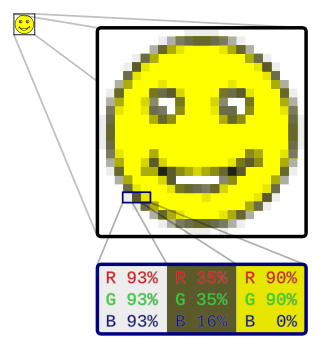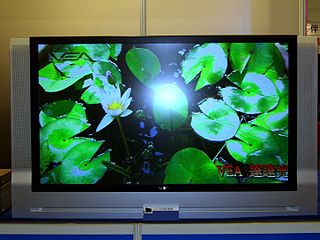There are three different addressing schemes for display devices: direct, matrix, and raster. The purpose of each scheme is to set (or maintain) the state of a pixel to either black/white or, more commonly, a grayscale level.
There are three different addressing schemes for display devices: direct, matrix, and raster. The purpose of each scheme is to set (or maintain) the state of a pixel to either black/white or, more commonly, a grayscale level.
A direct addressed display runs individual control signals to each pixel. This allows the state, whether on/off or grayscale, to be set and maintained on each pixel. For a screen size of m×n pixels, this scheme would require m×n control signals. This is generally considered to be an inefficient use of I/O and physical space.
A matrix addressed display runs control signals only to the rows (lines) and columns of the display. (See also: Display matrix) For a screen size of m×n pixels, this scheme requires m+n control signals. To address all pixels of such a display in the shortest time, either entire rows or entire columns have to be addressed sequentially. As many images are shown on a 16:9 aspect ratio, the sequential addressing is typically done row-by-row (i. e. line-by-line). In this case, fewer rows than columns have to be refreshed periodically. Passive matrix addressing is used with the help of persistence of vision of the (usually human) eye so the cell need not be bistable. Persistence of vision is used in simpler, slower changing displays with relatively few picture elements such as clocks. In active matrix addressing, some sort of capacitor (external to the cell proper) is used to maintain the state of the cell. When the electro-optical property of cells itself is bistable, passive matrix addressing without external capacitor can be implemented.
A raster addressed display (e.g., a CRT) works by scanning across the entire display in sequence while modulating control signal to activate each pixel as it is scanned. This display uses persistence of the pixel element (e.g., phosphor) to maintain the pixel state until the scan can visit that pixel again. There are only three control signals required for this to work: a horizontal scan control signal, a vertical scan control signal, and an intensity control signal. Timing between these signals is very important, else the image on the screen will show artifacts.

A liquid-crystal display (LCD) is a flat-panel display or other electronically modulated optical device that uses the light-modulating properties of liquid crystals combined with polarizers to display information. Liquid crystals do not emit light directly but instead use a backlight or reflector to produce images in color or monochrome.

In computer graphics and digital photography, a raster graphic represents a two-dimensional picture as a rectangular matrix or grid of pixels, viewable via a computer display, paper, or other display medium. A raster image is technically characterized by the width and height of the image in pixels and by the number of bits per pixel. Raster images are stored in image files with varying dissemination, production, generation, and acquisition formats.

A dot matrix is a 2-dimensional patterned array, used to represent characters, symbols and images. Most types of modern technology use dot matrices for display of information, including mobile phones, televisions, and printers. The system is also used in textiles with sewing, knitting and weaving.

A framebuffer is a portion of random-access memory (RAM) containing a bitmap that drives a video display. It is a memory buffer containing data representing all the pixels in a complete video frame. Modern video cards contain framebuffer circuitry in their cores. This circuitry converts an in-memory bitmap into a video signal that can be displayed on a computer monitor.

The VIC-II, specifically known as the MOS Technology 6567/6566/8562/8564, 6569/8565/8566 (PAL), is the microchip tasked with generating Y/C video signals and DRAM refresh signals in the Commodore 64 and Commodore 128 home computers.
Active matrix is a type of addressing scheme used in flat panel displays. It is a method of switching individual elements of a flat panel display, known as pixels. Each pixel is attached to a transistor and capacitor that actively maintain the pixel state while other pixels are being addressed, in contrast with the older passive matrix technology in which each pixel must maintain its state passively, without being driven by circuitry.

The Color Graphics Adapter (CGA), originally also called the Color/Graphics Adapter or IBM Color/Graphics Monitor Adapter, introduced in 1981, was IBM's first color graphics card for the IBM PC and established a de facto computer display standard.
Passive matrix addressing is an addressing scheme used in early LCDs. This is a matrix addressing scheme meaning that only m + n control signals are required to address an m × n display. A pixel in a passive matrix must maintain its state without active driving circuitry until it can be refreshed again.

In electronics, a sample and hold circuit is an analog device that samples the voltage of a continuously varying analog signal and holds its value at a constant level for a specified minimum period of time. Sample and hold circuits and related peak detectors are the elementary analog memory devices. They are typically used in analog-to-digital converters to eliminate variations in input signal that can corrupt the conversion process. They are also used in electronic music, for instance to impart a random quality to successively-played notes.
Text mode is a computer display mode in which content is internally represented on a computer screen in terms of characters rather than individual pixels. Typically, the screen consists of a uniform rectangular grid of character cells, each of which contains one of the characters of a character set; at the same time, contrasted to graphics mode or other kinds of computer graphics modes.

The Motorola 6845, or MC6845, is a display controller that was widely used in 8-bit computers during the 1980s. Originally intended for designs based on the Motorola 6800 CPU and given a related part number, it was more widely used alongside various other processors, and was most commonly found in machines based on the Zilog Z80 and MOS 6502.
A thin-film-transistor liquid-crystal display is a type of liquid-crystal display that uses thin-film-transistor technology to improve image qualities such as addressability and contrast. A TFT LCD is an active matrix LCD, in contrast to passive matrix LCDs or simple, direct-driven LCDs with a few segments.

An electronic component is any basic discrete electronic device or physical entity part of an electronic system used to affect electrons or their associated fields. Electronic components are mostly industrial products, available in a singular form and are not to be confused with electrical elements, which are conceptual abstractions representing idealized electronic components and elements. A datasheet for an electronic component is a technical document that provides detailed information about the component's specifications, characteristics, and performance. Discrete circuits are made of individual electronic components that only perform one function each as packaged, which are known as discrete components, although strictly the term discrete component refers to such a component with semiconductor material such as individual transistors.

Dual-ported video RAM (VRAM) is a dual-ported variant of dynamic RAM (DRAM), which was once commonly used to store the framebuffer in graphics adapters.

A raster scan, or raster scanning, is the rectangular pattern of image capture and reconstruction in television. By analogy, the term is used for raster graphics, the pattern of image storage and transmission used in most computer bitmap image systems. The word raster comes from the Latin word rastrum, which is derived from radere ; see also rastrum, an instrument for drawing musical staff lines. The pattern left by the lines of a rake, when drawn straight, resembles the parallel lines of a raster: this line-by-line scanning is what creates a raster. It is a systematic process of covering the area progressively, one line at a time. Although often a great deal faster, it is similar in the most general sense to how one's gaze travels when one reads lines of text.

Large-screen television technology developed rapidly in the late 1990s and 2000s. Prior to the development of thin-screen technologies, rear-projection television was standard for larger displays, and jumbotron, a non-projection video display technology, was used at stadiums and concerts. Various thin-screen technologies are being developed, but only liquid crystal display (LCD), plasma display (PDP) and Digital Light Processing (DLP) have been publicly released. Recent technologies like organic light-emitting diode (OLED) as well as not-yet-released technologies like surface-conduction electron-emitter display (SED) or field-emission display (FED) are in development to supersede earlier flat-screen technologies in picture quality.

Multiplexed displays are electronic display devices where the entire display is not driven at one time.
An electronic visual display is a display device that can display images, video, or text that is transmitted electronically. Electronic visual displays include television sets, computer monitors, and digital signage. They are ubiquitous in mobile computing applications like tablet computers, smartphones, and information appliances. Many electronic visual displays are informally referred to as screens.
LCD crosstalk is a visual defect in an LCD screen which occurs because of interference between adjacent pixels.